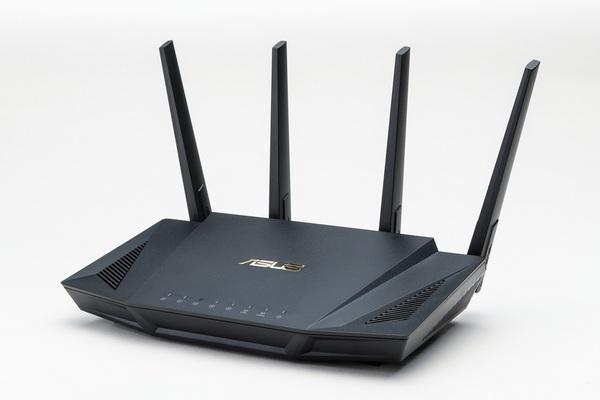ASCII.jp Verified Wi-Fi 6 router "RT-AX3000" with 20,000 yen cut, maximum speed of 2402 Mbps
In order to comfortably use smartphones and laptops, the performance of the Wi-Fi (wireless LAN) router installed in the house is essential. And the point in distinguishing between good and bad Wi-Fi routers is the corresponding "Wi-Fi standard". This is directly related to the speed of communication. In recent Wi-Fi standards, "Wi-Fi 5" (IEEE802.11ac) is the baseline, but the number of models compatible with the latest "Wi-Fi 6" (IEEE802.11ax) is increasing. From now on, if you want to prepare or renovate the Wi-Fi environment, it is a smart strategy to unify both wireless LAN and devices such as PCs and smartphones to Wi-Fi 6.
In the meantime, ASUS announced the low-priced model "RT-AX3000" of the Wi-Fi 6 compatible router. Until recently, the company's Wi-Fi 6 routers were mostly high-end models with crab-like antennas. The maximum communication speed is 4804 Mbps (theoretical value when using the 5 GHz band, the same applies below), which is super fast, but the price is around 50,000 yen, which is hard to say. On the other hand, the RT-AX3000 is a middle-class model with a maximum communication speed of 2402 Mbps and sold at less than half the price of 20,000 yen.
ASUS' latest Wi-Fi 6 router "RT-AX3000". The maximum communication speed is 2402 Mbps, and the actual selling price is around 19,800 yen, which is a very affordable price range for a Wi-Fi 6 compatible router.
Currently, the mainstream Wi-Fi 5 router is 433 Mbps to 1766 Mbps, but the RT-AX3000's communication speed (maximum 2402 Mbps) is much higher. Now, I would like to verify how fast the RT-AX3000 is compared to conventional Wi-Fi 5 compatible routers.
Recently, Wi-Fi routers labeled as gaming routers are mainly large products with many antennas like crabs. High-speed communication requires a high-spec CPU for signal processing and multiple antennas. However, it is difficult to install in a general household because it becomes large when performance is improved.
On that point, the RT-AX3000 has four antennas and a compact footprint of 224mm x 154mm. It has four antennas, two of which are in charge of the 5GHz band (maximum 2402Mbps) and the remaining two are in charge of the 2.4GHz band (maximum 574Mbps). Some high-end models can output up to 4804 Mbps using 4 wires in the same band, but since many Wi-Fi 6 compatible devices (especially PCs) have 2 antennas, the Wi-Fi 6 router side also has an antenna. I would say two is enough.

Antennas standing on a Wi-Fi router help ensure signal strength, and the number of antennas increases communication speed. The RT-AX3000 is designed for 2x2 communication (2 antennas) on both the 2.4GHz and 5GHz bands.
There are 4 LAN ports (for home LAN) on the back, and 1 LAN port for connecting to home wiring and ONU. All are gigabit LAN (1000BASE-T) specifications. You can also connect an external HDD to USB 3.0 (USB 3.1 Gen 1) and operate it like a file server.
The attached AC adapter is also small compared to the high-end model
In addition, the strength of the latest Wi-Fi 6 compatible router is not only the improvement of communication speed. First, Wi-Fi 6 is strong when communicating with multiple devices. Nowadays, not only PCs and smartphones, but also home appliances such as printers, smart speakers, game consoles and TVs use Wi-Fi. Wi-Fi 6 allows for more efficient communication with multiple devices than Wi-Fi 5, so it is more suitable for situations such as watching videos while enjoying games on Wi-Fi.
In addition, Wi-Fi 6 communication also incorporates a function called "Target Wake Time (TWT)" that reduces the power consumption of connected devices, and according to ASUS, the device side to maintain Wi-Fi communication It is said that the power consumption of is reduced by up to 1/7. However, the functions around here can demonstrate their true value by matching the device side that communicates with the Wi-Fi router to Wi-Fi 6, so it is not possible to immediately realize all of the functions.
However, Wi-Fi routers are one of the peripheral devices that are very troublesome to replace once you start using them. In particular, it is often troublesome to change the Wi-Fi settings of home appliances and smart devices. And there will be more and more Wi-Fi 6 compatible devices in the future. That's why if you buy a Wi-Fi router now, updating to the Wi-Fi 6 router that has just started to appear should help reduce the hassle in the future.
When there are multiple devices using Wi-Fi communication, with Wi-Fi 5 (left), the data is sent from the router one device at a time, so the lag increases, but with Wi-Fi 6 (right) ), you can send data to multiple devices at the same time in one communication (excerpt from ASUS website)
In Wi-Fi 5, the Wi-Fi circuit is energized while waiting for communication, but in Wi-Fi 6, Wi-Fi can be put to sleep between waiting periods, so Wi-Fi It is said that the power consumption of
Wi-Fi 6 not only has a faster communication speed, but also a longer range of radio waves. According to ASUS, the radio coverage area will be 80% wider than Wi-Fi 5, but really ...






![[July 6 and 7] DX realized by content cloud, advanced platform for business transformation](https://website-google-hk.oss-cn-hongkong.aliyuncs.com/drawing/article_results_9/2022/3/9/6bbafe438d78271513761788166cbf94_0.jpeg)

